Salvo!
Review by By Jim
Cobb
August 16, 2005 |
 On
reflection, a turn-based game is a very good format for an Age of
Sail simulation. Movement to contact could often take hours during
this period so that real-time games such as Age of Sail II:
Privateer’s Bounty have a somewhat anachronistic feel for the first
stage of a battle because action begins soon after loading a
scenario. Once contact was made, of course, combat was fast and
furious. Capturing the feel for both stages of sea warfare and
simulating the complexity of such combat is a challenge. Salvo!
makes long strides in meeting this challenge, although the game has
the earmarks of a work-in-progress.
On
reflection, a turn-based game is a very good format for an Age of
Sail simulation. Movement to contact could often take hours during
this period so that real-time games such as Age of Sail II:
Privateer’s Bounty have a somewhat anachronistic feel for the first
stage of a battle because action begins soon after loading a
scenario. Once contact was made, of course, combat was fast and
furious. Capturing the feel for both stages of sea warfare and
simulating the complexity of such combat is a challenge. Salvo!
makes long strides in meeting this challenge, although the game has
the earmarks of a work-in-progress.
Midshipmen’s Lessons
Salvo!’s developers at
SprueGames realized the complexity of their product and took
measures to lessen the learning curve by providing a 49-page bound
manual, four tutorials and two "sand box" (wading pool?) exercises.
The manual is extensive if lacking some details and fairly
well-organized although more illustrations could have helped.
Undocumented features include:
/ select next ship which can move
\ select next ship which can fire
T save current camera location
R return to saved camera location
(can be used repeatedly to return to
successive saved camera locations
|
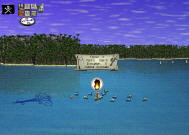
|
|
Before being
ignited, this fire ship shows all possible movement. |
The tutorials provide a step-by-step
approach to learning game concepts. Beginning one starts not only a
scenario but a detailed HTML instruction document in a minimized
window. Switching from the detailed instructions to play is
seamless. The first tutorial teaches movement and basic gunnery
while the second introduces crew management and boarding. The third
deals with creating and handling squadrons, a vital aspect of the
game. The fourth tutorial introduces special units such as fireships,
shore fortifications and floating batteries. Here, the essentials of
campaign components are also explained. Some players may complain
that the tutorials are too long and jump right into a campaign but
they’ll soon be back to class after the AI scuttles them.
Hardtack and Short Rations
The tutorials reveal the
irritating parts in Salvo!. Camera views and controls are jerky when
clicking to select different ships. Scrolling with either arrow keys
or mouse often stops in the main screen, preventing an overview of a
situation. An overview can be obtained from the battle map but that
screen lacks a zoom feature, making selection of individual ships
difficult. Cursors seem out of sync with the objects on the screen
so that selecting a movement arrow sometimes requires placing the
cursor not on but near the arrow. Since the camera view immediately
shifts to a ship when it’s selected, action markers are often
off-screen, causing players to spend time changing view points to
see if any actions are possible. Ships are zoomed "to" instead of
"in". On the battle map, way markers sometimes appear to be in one
place where they are in another on the main screen. For instance, a
marker apparently in deep water on the battle map may actually be in
a shoal. Perhaps this problem simulates the possibility of running
aground through bad maps.
A perplexing choice of function is
the save/reload interface. "Save" will re-write the original file,
although "Revert" re-sets the original scenario. "Save Special"
allows players to name a file. Renaming seems fine until a player
wants to re-load. He can page through all twenty-four battles and
campaigns until the saved game page is reached or hit the "End" key.
Loading brings up a regular "Open" dialog and the saved game won’t
be listed because the file type is "Battle" and the games are saved
as TXT. The work around is to remember the first letters of the
save, tack on a wildcard and enter them in the file name window; the
file should then appear. Players are thus advised to use easily
remembered file names. Why such an uncommon procedure was used is a
mystery.
Unfortunately, these flaws may ward
off casual gamers who are used to smoother interfaces. They are
missing an extraordinary game. Players who play through these
irritants will be rewarded.
Almost Bristol Fashion
Changes in graphics come so rapidly
these days that the term "state of the art" is meaningless. Instead,
graphics should be rated in terms of how they facilitate gameplay.
Salvo! shines in how it depicts the sea and ships. The many
different vessel types are depicted lovingly and accurately,
although the high poops of earlier ships are not shown well.
|
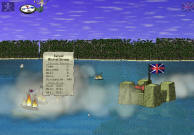
A shore battery
blazes away is a tropical paradise turned inferno.
|
|
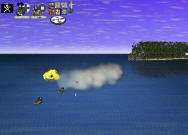
A ship explodes under
the fire of a floating battery. |
Close up, rigging, yardarms and gun
ports can be seen. When ships slow, the mainsails are furled.
Pennants stream in the wind. Combat sees ragged tears in sheets and
ropes, holes in gunwales, masts go by the board and fires that can
lead to spectacular explosions can break out. Smoke, with three
different player-chosen levels, can blanket a battle. Waves can be
calm or furious. Shoals can be seen as greenish marks under the
surface. For naval action, the graphics in Salvo! serve their
purpose most admirably.
Shore and land objects tend to be
secondary to most naval games; so much so that they are usually left
out. Salvo! recognizes the importance of harbors, reefs and shore
installations. If the land graphics don’t have the quality of their
aquatic counterparts, the difference doesn’t detract from gameplay.
Channels between islands seem to be sliced with a sharp knife and
looking at a ship from around a point seems like peeping around a
wall of green. Structures are simple and plain. These criticisms are
secondary to the fact that land and coastal features are portrayed
in this game better than any other naval game.
Unlike many games, the interface of
Salvo! is largely graphical. Squadron commands, crew management and
ammunition selection is done on a small screen that pens up with a
right click on a ship. Making changes is simply a matter of clicking
on an arrow or a simple icon. Movement orders are given by clicking
on arrows along a ship’s path. An outstanding if unusual feature is
the combination of different cursors and action markers. When a ship
can move, the cursor becomes a steering wheel. If a ship can fire,
the cursor becomes crossed cannon and a flaming cannon ball with the
range appears over the target. Click on the marker and – BOOM!
Object markers appear near a ship if she can perform an action, e.g.
a grappling hook appears if ships are close, crossed swords show up
if boarding is possible or an axe is there to unfoul. Players merely
click to perform an action. Hovering cursors show the present state
of a ship and a click opens a more detailed description. Wind
direction and compass headings are clearly marked.
Sound is barebones. Players hear only
the "Huzza" of crews, the crash of broadsides and the gentle lapping
of the waves.
"She Handles Lively!"
|
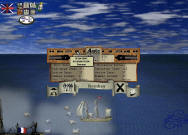
This screen selects
the ammunition type.
|
|
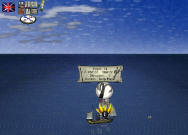
A British ship can
rake at short range and then board. |
When players get past the flaws
mentioned above, the innovation of Salvo! can be appreciated. The
sailing model is perfect. Arrows show the direction and distance a
selected ship can move. Thus, a vessel heading into the when can
only go one arrow. Not going the full distance has ramification of
not moving faster for another turn. If left alone, a ship "in irons"
will eventually "fall off" into the wind. Since this process takes
time, a "tacking" arrow is provided. Tacking allows some movement
into the wind but requires some skill. A low-rated captain and crew
may fumble a tack. Players do not have to manage each ship as
automove will move unselected ships in the last direction. The
efficacy of such moves depends on the quality of the ship and her
captain as well as the crew’s morale.
Clicking on a ship after movement may
allow cannon fire with targets marked as described above. Ammunition
comes in five flavors: ball, double ball, chain/link to take out
rigging and spares, grape/canister to clear decks and the double
purpose ball/canister. Each type has its own ranges as can be seen
through togglable broadside arcs. Effectiveness of fire depends on
range, position, e.g. rake, number of guns manned and crew quality.
Crew quality reflects the number of broadsides a crew can fire
within a five-minute turn. A well-trained crew will fire the
equivalent of three broadsides with one fire action. Fire combat
results in the damage described above as well as crew casualties and
disruption.
The next type of combat is boarding.
With ships grappled or fouled, the player construct boarding parties
using marines (with pirates, "marines" are crew always on boarding
duty), sailors and armed sailors. A window allows players to raise
or lower the number of men in each group within the boarding party.
Boarding combat is resolved automatically.
|
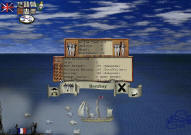
Positions can be manned
here.
|
|
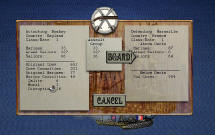
These lads are about to
sweep the decks clear of the scurvy foe. |
Sailing, gunnery and boarding depends
on a very innovative aspect of Salvo!: crew management.
Right-clicking on a ship and selecting the crew icon opens a display
showing the six positions crews are assigned to: idlers, both
batteries, sailing, damage control and boarding party. The display
also shows the level that each position is manned. Since ships are
usually not at full compliment, players must decide how many crew to
allocate to what positions during which phase. Moving to contact
should have a healthy sailing division while an engaged side needs a
well-manned battery. Armed sailors are more useful than regular
sailors in boarding so players should put some men in "idlers" and
then move then to "boarding party" a turn or so before they go over
the side.Using icons on the battle map, ships
can be set to three different control modes, two of which gives the
captains freedom of action. Of course, players can manually override
these modes so they can choose the detail of management they desire.
A final mechanic that helps play is
"fast" mode. Since movement can take a while, hitting "f" speeds
ships on the direction they’re headed or to waypoints quicker than
normal. This mode stops at player intervention or when certain
events occur.
"Signal from the Flagship – Our
Number"
|
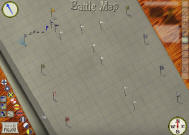
On the battle map, a
squadron in line makes its way to the last waypoint.
|
|
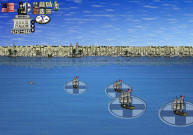
Squadron markings are
seen on the main screen. |
Salvo! is unique in that it portrays
large fleet actions. Ordering each ship would tax even the most
devoted sea dog. The squadron mode gets around this problem. Up to
nine squadrons of any size can be formed. Squadrons can be formed on
both the main screen and the battle map. Choosing the best captain,
the first ship is selected as flag and the "Create squadron" icon is
clicked. Adding other ships is a simple right-click followed by
hitting "Add to squadron". Each squadron has its own symbol that can
be displayed beneath the ships. Each squadron has three flags, two
to mark movement goals and one to mark a point where ships should
take actions. Squadron orders include hold, follow the flagship,
form line, engage and close action. Players can exert temporary
override of any ship in a squadron. The squadron system, combined
with fast mode, takes away much of the grunge work of fleet
operations.
"To Add Something More to this
Wonderful Year"
Victory in Salvo! is gained by
points. Capturing, sinking or damaging enemy ships while keeping
friendly losses low is a familiar way of racking up a score but
tactical goals are also evident. These goals are represented by
flags that each side strives to capture by having their ships
nearest. Levels of victory enhance players’ prestige with
commiserate rewards at battle’s end.
|
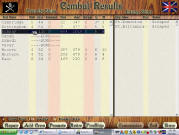
The end of battle
screen shows the fruits of victory.
|
|
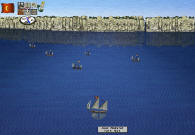
A lanteen-rigged sloop
waits to pounce. |
In campaigns, the fruits of victory
are numerous. Players at the end of a successful battle can sell
captured ships or incorporate then into their fleet. Repair points
are earned and can be distributed as can morale-boosting promotion
points and extra crew. If an attack on a harbor is expected, players
may want to convert some vessels to fire ships in order to wreak
havoc on anchored enemies. Players must think ahead with the end of
battle screen.
The twenty-four campaigns and battles
range from the seventeenth century to the Napoleonic Wars. Although
no historical battles per se are included, the scenarios have the
right feel without arguments over nits. Players can handle Philip
II’s second go at Elizabethan England, romp up the Thames with
Admiral Tromp, savage the Caribbean as a pirate, engage as a
commander of both sides in the century-long struggle between France
and England, ward off the British and punish the pirates of Tripoli
as American or continue to harass the Europeans as the Dey of
Algiers. Every conceivable condition and mission, such as cutting
out and shore bombardment, can be found. The clever AI and multiple
levels of difficulty make up partially for the lack of a
multi-player component and the variety of campaigns should
compensate for the lack of an editor.
Like any new system, Salvo! has its
rough edges. We hope SprueGames continues to see this product
through with smoother controls, multi-play, more campaigns and an
editor. However, the game is fine now and is extremely laudable in
its innovations. Every serious student of the Age of Sail needs this
game.
Publisher:
Shrapnel Games
Developer SprueGames
 |
Discuss Salvo! in the Subsim
Radio Room! |
| |
SYSTEM REQUIREMENTS: Pentium 600 MHz (1000 MHz Optimal) , 256
MB RAM (512 MB optimal), Windows 95+; 500+ MB Hard Drive
Space, CD ROM , Windows Compatible Sound Card, SVGA Video Card
(800 x 600 with 16 bit color or better)
Mac OS X 10.1.5 or Higher, 1 GHz G4 (1 GHz + Optimal), 256 MB
RAM (512 MB optimal), 2 Button Mouse Recommended, CD ROM, 500+
MB Hard Drive Space, SVGA Video Card (800 x 600 with 16 bit
color or better)
|

